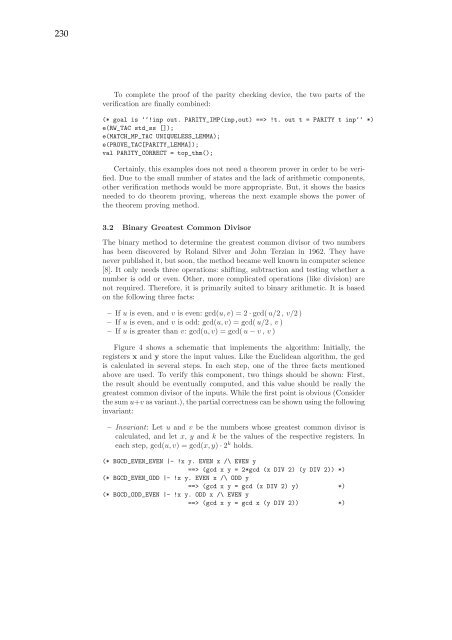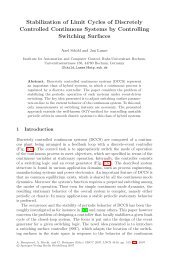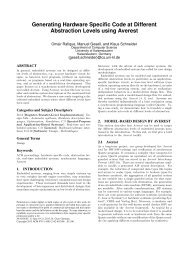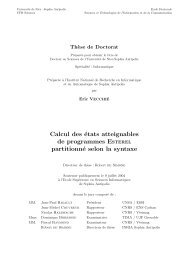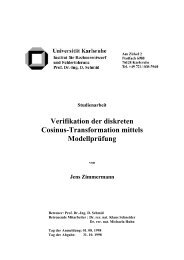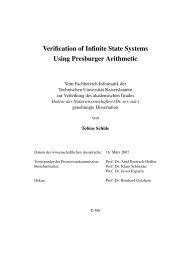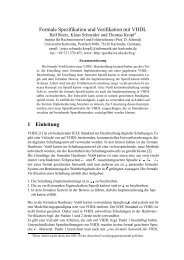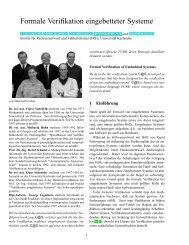Verifikation reaktiver Systeme - Universität Kaiserslautern
Verifikation reaktiver Systeme - Universität Kaiserslautern
Verifikation reaktiver Systeme - Universität Kaiserslautern
Sie wollen auch ein ePaper? Erhöhen Sie die Reichweite Ihrer Titel.
YUMPU macht aus Druck-PDFs automatisch weboptimierte ePaper, die Google liebt.
230<br />
To complete the proof of the parity checking device, the two parts of the<br />
verification are finally combined:<br />
(* goal is ‘‘!inp out. PARITY_IMP(inp,out) ==> !t. out t = PARITY t inp‘‘ *)<br />
e(RW_TAC std_ss []);<br />
e(MATCH_MP_TAC UNIQUELESS_LEMMA);<br />
e(PROVE_TAC[PARITY_LEMMA]);<br />
val PARITY_CORRECT = top_thm();<br />
Certainly, this examples does not need a theorem prover in order to be verified.<br />
Due to the small number of states and the lack of arithmetic components,<br />
other verification methods would be more appropriate. But, it shows the basics<br />
needed to do theorem proving, whereas the next example shows the power of<br />
the theorem proving method.<br />
3.2 Binary Greatest Common Divisor<br />
The binary method to determine the greatest common divisor of two numbers<br />
has been discovered by Roland Silver and John Terzian in 1962. They have<br />
never published it, but soon, the method became well known in computer science<br />
[8]. It only needs three operations: shifting, subtraction and testing whether a<br />
number is odd or even. Other, more complicated operations (like division) are<br />
not required. Therefore, it is primarily suited to binary arithmetic. It is based<br />
on the following three facts:<br />
– If u is even, and v is even: gcd(u, v) =2· gcd( u/2 ,v/2)<br />
– If u is even, and v is odd: gcd(u, v) =gcd(u/2 ,v)<br />
– If u is greater than v: gcd(u, v) =gcd(u − v, v)<br />
Figure 4 shows a schematic that implements the algorithm: Initially, the<br />
registers x and y store the input values. Like the Euclidean algorithm, the gcd<br />
is calculated in several steps. In each step, one of the three facts mentioned<br />
above are used. To verify this component, two things should be shown: First,<br />
the result should be eventually computed, and this value should be really the<br />
greatest common divisor of the inputs. While the first point is obvious (Consider<br />
the sum u+v as variant.), the partial correctness can be shown using the following<br />
invariant:<br />
– Invariant: Letu and v be the numbers whose greatest common divisor is<br />
calculated, and let x, y and k be the values of the respective registers. In<br />
each step, gcd(u, v) =gcd(x, y) · 2 k holds.<br />
(* BGCD_EVEN_EVEN |- !x y. EVEN x /\ EVEN y<br />
==> (gcd x y = 2*gcd (x DIV 2) (y DIV 2)) *)<br />
(* BGCD_EVEN_ODD |- !x y. EVEN x /\ ODD y<br />
==> (gcd x y = gcd (x DIV 2) y) *)<br />
(* BGCD_ODD_EVEN |- !x y. ODD x /\ EVEN y<br />
==> (gcd x y = gcd x (y DIV 2)) *)


